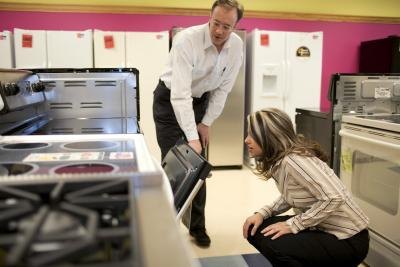Appliances, especially large or broken ones, can seem daunting to recycle. There are too many different kinds of materials and parts to be dropped in a recycling bin, and dismantling them yourself can be both time-consuming and potentially dangerous. Seattle is one of the greenest cities in the country and has many recycling programs for large and small appliances. For functioning appliances, you can even donate them so they can be reused.
-
Mike's Appliance Recycling - Seattle, WA
www.yelp.com/biz/mikes-appliance-recycling-seattle
12/26/2012 (206) 327-8261 "Some people collect baseball cards. Others tea cups or stuffed animals. I, quite subconsciously have been collecting spent hot water ...
-
How to Recycle Old Kitchen Appliances and Fun Ways to Use Them in ...
ezinearticles.com/?How-to-Recycle-Old-Kitchen-Appliances-and-Fun...
11/15/2007 Do you have a lot of old kitchen appliances that you want to get rid of? What about defective kitchen appliances that you want to throw away? Before you ...
-
Green Guide to Recycling Appliances and Electronics PartSelect.com
www.partselect.com/JustForFun/Guide-to-Recycling-Appliances-and...
If you need to recycle old appliances and electronics, follow these green guidelines to dispose of them safely and properly.
-
How to Recycle a Refrigerator eHow
www.ehow.com/how_4555339_recycle-a-refrigerator.html
How to Recycle a Refrigerator. Maybe the refrigerator you've had for the past 20 years is on its last leg. Maybe you decided to cut your energy costs by investing in ...
-
FREE Appliance Removal and Recycling Seattle eBay Classifieds ...
seattle.ebayclassifieds.com/other/seattle/free-appliance-removal...
Address: Seattle, WA 98166 Date Posted: 07/07/13; Description: Mike's Appliance Recycling offers free pick-up and Removal of your old ...
-
NYCWasteLess: What to Recycle with Sanitation
www.nyc.gov/html/nycwasteless/html/recycling/recycle_what.shtml
Recycling requirements for NYC residences, schools, institutions, and agencies serviced by the Department of Sanitation.
-
Seattle City Light Conservation Appliances Refrigerator Recycling
www.seattle.gov/light/conserve/resident/appliances/cv5_appA2.htm
Do you have an old working refrigerator in your basement or garage? Seattle City Light will pay you to get rid of it! Older refrigerators and freezers can use 34 ...
-
Appliance Recycling Outlet in Snohomish, WA - Reviews and Directions
www.citysearch.com/.../snohomish_wa/appliance_recycling_outlet.html
Great deals and great customer service! I have bought many different appliances from this outlet and never once been dissappointed. The owner is a very fair person ...
-
Seattle Appliance Removal and Appliance Recycling
www.buzz-bee.net/applianceremoval
Seattle Appliance Removal and Appliance Recycling. Appliance Removal Service: Need an appliance removal and recycling service? Someone to pick up and haul away your ...
-
Recycling--Seattle Public Utilities
www.seattle.gov/util/myservices/recycling
Benefits of Recycling. Reduces the need for landfills; Prevents pollution caused by the manufacturing of products; Saves energy; Decreases emissions of greenhouse gases
-
Portland Appliance Recycling in Portland, OR DexKnows.com
www.dexknows.com/.../geo/c-portland-or/att/appliances-recycling
Local business listings / directory for Appliance Recycling in Portland, OR. Yellow pages, maps, local business reviews, directions and more for Appliance Recycling ...
-
Seattle Junk Removal - Hauling - Recycling Rubbish Works
www.rubbishworks.com/seattle
Rubbish Works offers Seattle and Bellevue roll off dumpster rentals and junk removal services, including labor, hauling, waste disposal, rubbish pickup and recycling ...
-
Recycling Earth911.com
earth911.com/recycling
Have something to recycle? Get answers to all your recycling questions below and search for whats available in your neighborhood.
-
Snohomish Appliance Recycling in Snohomish, WA DexKnows.com
www.dexknows.com/.../geo/c-snohomish-wa/att/appliances-recycling
Local business listings / directory for Appliance Recycling in Snohomish, WA. Yellow pages, maps, local business reviews, directions and more for Appliance Recycling ...
-
West Seattle Recycling
www.westseattlerecycling.com
In Business Since 1979 : West Seattle Recycling 3881 16th Ave SW Seattle, WA 98106 Google Map. Voice: (206) 935-4255 Fax: (206) 935-1791. Open MonSat. 9a 5:30p
-
How Best Buy makes money recycling America's electronics ...
www.greenbiz.com/blog/2012/04/24/how-best-buy-makes-money...
Retailing giant Best Buy (NYSE: BBY) has seen its recycling take-back program grow from a costly gamble into a fast-growing business thats making a little bit of ...
-
Welcome to Seattle Home Appliance- Bothell - Shoreline - Sumner ...
www.seattlehomeappliance.com
Seattle Home Appliance is your premier kitchen and laundry appliance retailer.Seattle Home Appliance serves customers throughout Washington, including Everett ...
-
Appliance Recycling Program PEPCO - Pepco's Energy Saving ...
homeenergysavings.pepco.com/appliance-recycling-program/how-to...
How to Participate. Schedule a recycling pick-up today! Use the Online Scheduler. OR. Call us at 877.395.5540. Eligibility. You must be a Pepco customer with an ...
-
Earth911.com More Ideas, Less Waste
earth911.com
Guide to local resources including recycling centers, how to recycle, pollution prevention and how help protect the environment.
-
How to Recycle and Donate Computers, InterConnection Computer ...
computers.interconnection.org/whatwetake.htm
InterConnection Computer Reuse Center accepts working and non working computers for recycle and reuse. Teachers computer hardware skills. Provides computers to non ...




























